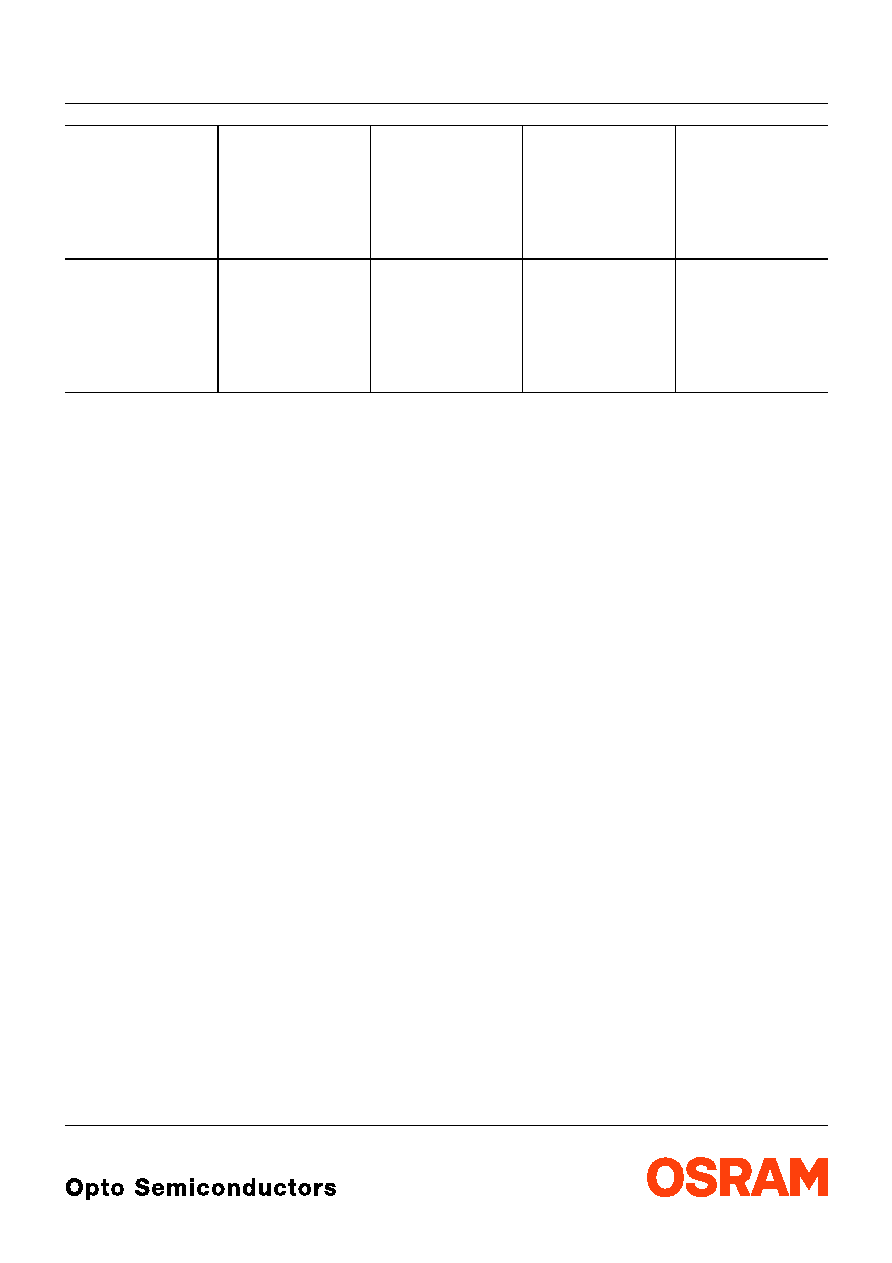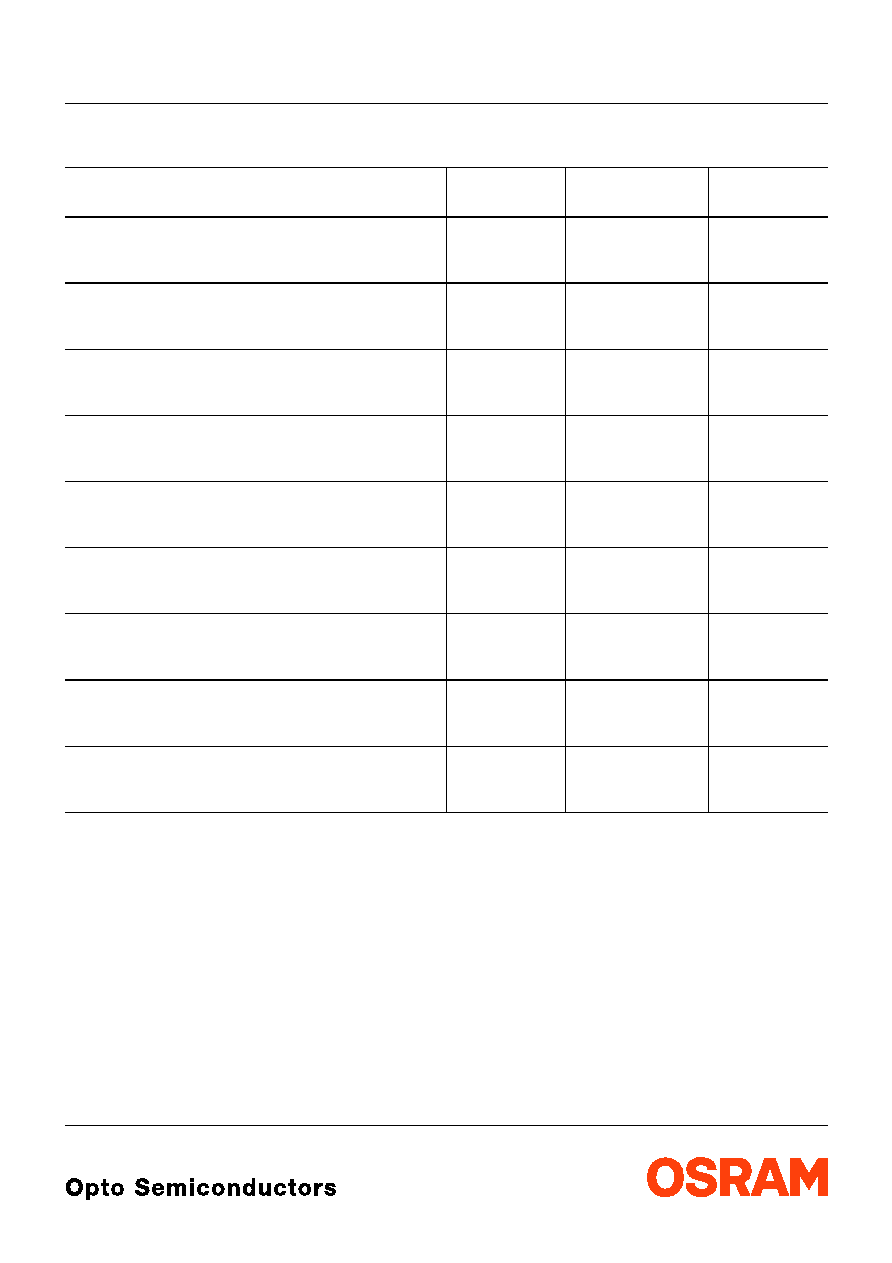 | –≠–ª–µ–∫—Ç—Ä–æ–Ω–Ω—ã–π –∫–æ–º–ø–æ–Ω–µ–Ω—Ç: LBK376 | –°–∫–∞—á–∞—Ç—å:  PDF PDF  ZIP ZIP |

LB K376
BLUE LINE
TM
Hyper ARGUS
Æ
LED
Hyper-Bright, 3 mm (T1) LED, Non Diffused
2001-02-08
1
Besondere Merkmale
∑ Geh‰usetyp: nicht eingef‰rbtes, klares 3 mm
(T1) Geh‰use mit spezieller Linse
∑ Besonderheit des Bauteils: mit Einsatz eines
‰uþeren Reflektors zur Hinterleuchtung von
Leuchtfeldern und LCD-Anzeigen; Lˆtspieþe
mit Aufsetzebene
∑ Wellenl‰nge: 465 nm
∑ Abstrahlwinkel: angepasst an Einsatz mit
‰uþerem Reflektor, siehe Diagramm
∑ Technologie: GaN
∑ Gruppierungsparameter: Lichtstrom
∑ Lˆtmethode: Wellenlˆten (TTW)
∑ Verpackung: Sch¸ttgut, gegurtet lieferbar
∑ ESD-Festigkeit: ESD-sicher bis 2 kV nach
EOS/ESD-5.1-1993
Anwendungen
∑ optischer Indikator
∑ Hinterleuchtung (LCD, Schalter, Tasten,
Displays, Werbebeleuchtung,
Allgemeinbeleuchtung)
∑ Innenbeleuchtung im Automobilbereich
(z.B. Instrumentenbeleuchtung, u.‰.)
∑ Einkopplung in Lichtleiter
Features
∑ package: colorless, clear 3 mm (T1) package
with specially shaped lens
∑ feature of the device: for backlighting and
LCDs with use of a reflector; solder leads with
stand-off
∑ wavelength: 465 nm
∑ viewing angle: matched to use with external
reflector, see diagram
∑ technology: GaN
∑ grouping parameter: luminous flux
∑ soldering methods: TTW soldering
∑ packing: bulk, available taped on reel
∑ ESD-withstand voltage: up to 2 kV acc. to
EOS/ESD-5.1-1993
Applications
∑ optical indicators
∑ backlighting (LCD, switches, keys, displays,
illuminated advertising, general lighting)
∑ interior automotive lighting (e.g. dashboard
backlighting, etc.)
∑ coupling into light guides

2001-02-08
2
LB K376
Helligkeitswerte werden mit einer Stromeinpr‰gedauer von 25 ms und einer Genauigkeit von ±11 % ermittelt.
Luminous intensity is tested at a current pulse duration of 25 ms and a tolerance of ±11 %.
Anm.: Die Standardlieferform von Serientypen beinhaltet eine untere bzw. eine obere Familiengruppe
oder mindestens zwei Einzelgruppen.
In einer Verpackungseinheit / Gurt ist immer nur eine Helligkeitsgruppe enthalten.
Die technologiebedingte Helligkeits-Streuung der heutigen LED-Herstellprozesse ¸ber einen
l‰ngeren Fertigungszeitraum (Halbleitermaterial - Chipherstellung - Montageprozesss) erlaubt
keine Zusage einer einzelnen Helligkeitsgruppe. Daher m¸ssen mindestens zwei
Helligkeitsgruppen vorgesehen werden!
Note: The standard shipping format for serial types includes a lower or upper family group or at least
two individual groups.
No packing unit / tape ever contains more than one luminous intensity group.
Luminosity variations caused by the technology used in current LED manufacturing processes
over a protracted manufacturing period (semiconductor material - chip fabrication - assembly
process) mean that it is not possible to assign LEDs to a single luminous intensity group. For this
reason at least two luminous intensity groups must be provided!
Typ
Type
Emissions-
farbe
Color of Emission
Farbe der
Lichtaustritts-
fl‰che
Color of the
Light Emitting
Area
Lichtstrom
Luminous Flux
I
F
= 10 mA
V
(mlm)
Bestellnummer
Ordering Code
LB K376
LB K376-L1
LB K376-L2
LB K376-M1
LB K376-M2
LB K376-N1
blue colorless
clear
11.2 ... 14.0
14.0 ... 18.0
18.0 ... 22.4
22.4 ... 28.0
28.0 ... 35.5
Q62703-Q4069

LB K376
2001-02-08
3
Grenzwerte
Maximum Ratings
Bezeichnung
Parameter
Symbol
Symbol
Wert
Value
Einheit
Unit
Betriebstemperatur
Operating temperature range
T
op
≠ 55 ... + 100
∞C
Lagertemperatur
Storage temperature range
T
stg
≠ 55 ... + 100
∞C
Sperrschichttemperatur
Junction temperature
T
j
+ 100
∞C
Durchlassstrom
Forward current
I
F
20
mA
Stoþstrom
Surge current
t
10
µ
s,
D
= 0.005
I
FM
0.2
A
Sperrspannung
Reverse voltage
V
R
5
V
Leistungsaufnahme
Power consumption
T
A
25 ∞C
P
tot
90
mW
W‰rmewiderstand
Thermal resistance
Sperrschicht/Umgebung
Junction/air
Sperrschicht/Lˆtpad
Junction/solder point
Montage auf PC-Board FR 4 (Padgrˆþe
16 mm
2
)
mounted on PC board FR 4 (pad size
16 mm
2
)
Minimale Beinchenl‰nge
Minimum lead length
R
th JA
R
th JS
500
280
K/W
K/W

2001-02-08
4
LB K376
Kennwerte (
T
A
= 25 ∞C)
Characteristics
Bezeichnung
Parameter
Symbol
Symbol
Wert
Value
Einheit
Unit
Wellenl‰nge des emittierten Lichtes
(typ.)
Wavelength at peak emission
I
F
= 10 mA
peak
428
nm
Dominantwellenl‰nge
(typ.)
Dominant wavelength
I
F
= 10 mA
dom
465
nm
Spektrale Bandbreite bei 50 %
I
rel max
(typ.)
Spectral bandwidth at 50 %
I
rel max
I
F
= 10 mA
60
nm
Durchlassspannung
1)
(typ.)
Forward voltage
1)
(max.)
I
F
= 10 mA
V
F
V
F
3.5
4.1
V
V
Sperrstrom
(typ.)
Reverse current
(max.)
V
R
= 5 V
I
R
I
R
0.01
10
µ
A
µ
A
Temperaturkoeffizient von
peak
(typ.)
Temperature coefficient of
peak
I
F
= 10 mA; ≠10∞C
T
100∞C
TC
peak
0.004
nm/K
Temperaturkoeffizient von
dom
(typ.)
Temperature coefficient of
dom
I
F
= 10 mA; ≠10∞C
T
100∞C
TC
dom
0.03
nm/K
Temperaturkoeffizient von
V
F
(typ.)
Temperature coefficient of
V
F
I
F
= 10 mA; ≠10∞C
T
100∞C
TC
V
≠ 3.1
mV/K
Optischer Wirkungsgrad
(typ.)
Optical efficiency
I
F
= 10 mA
opt
1
lm/W
1)
Spannungswerte werden mit einer Stromeinpr‰gedauer von 1 ms und einer Genauigkeit von ±0.1 V ermittelt.
Voltages are tested at a current pulse duration of 1 ms and a tolerance of ±0.1 V.

LB K376
2001-02-08
5
Relative spektrale Emission
I
rel
=
f
(
),
T
A
= 25 ∞C,
I
F
= 10 mA
Relative Spectral Emission
V(
) = spektrale Augenempfindlichkeit
Standard eye response curve
Abstrahlcharakteristik
I
rel
=
f
(
)
Radiation Characteristic
OHL00431
380
0
20
40
60
80
100
%
I
rel
V
blue
430
480
530
580
630
680
nm
0
0.2
0.4
1.0
0.8
0.6
1.0
0.8
0.6
0.4
0∞
10∞
20∞
40∞
30∞
OHL01277
50∞
60∞
70∞
80∞
90∞
100∞
0∞
20∞
40∞
60∞
80∞
100∞
120∞

LB K376
2001-02-08
6
Durchlassstrom
I
F
=
f
(
V
F
)
Forward Current
T
A
= 25 ∞C
Maximal zul‰ssiger Durchlassstrom
I
F
=
f
(
T
)
Max. Permissible Forward Current
Relativer Lichtstrom
V
/
V(10 mA)
=
f
(
I
F
)
Relative Luminous Flux
T
A
= 25 ∞C
Relativer Lichtstrom
V
/
V(25 ∞C)
=
f
(
T
A
)
Relative Luminous Flux
I
F
= 10 mA
V
OHL00432
F
F
I
V
5
1.5
2 2.5 3 3.5 4 4.5 5
6
10
-1
0
10
5
1
10
5
10
2
T
OHL00448
0
F
I
0
20
40
60
80 ∞C 100
mA
5
10
15
20
25
30
temp. solder point
temp. ambient
T
T
S
A
T
A
T
S
I
OHL00454
F
-1
10
V (10 mA)
10
-3
-2
-1
0
1
10
10
10
10
10
0
10
1
10
2
5
5
5
5
5
mA
V
T
OHL00455
0
V
-20
0
20
40
60
∞C
100
A
V
(25 ∞C)
0.2
0.4
0.6
0.8
1.2

LB K376
2001-02-08
7
Zul‰ssige Impulsbelastbarkeit
I
F
=
f
(
t
p
)
Permissible Pulse Handling Capability
Duty cycle
D
= parameter,
T
A
= 25 ∞C
Zul‰ssige Impulsbelastbarkeit
I
F
=
f
(
t
p
)
Permissible Pulse Handling Capability
Duty cycle
D
= parameter,
T
A
= 85 ∞C
OHL01433
F
I
10
10
-5
-4
-3
10
10
-2
10
-1
10
0
s
10
1
10
2
p
t
0.05
0.5
0.2
0.1
D
0.02
0.01
0.005
=
D
T
t
=
P
t
T
P
I
F
0
0.05
0.10
0.15
0.20
0.25
A
OHL01434
F
I
10
10
-5
-4
-3
10
10
-2
10
-1
10
0
s
10
1
10
2
p
t
0.05
0.5
0.2
0.1
D
0.02
0.01
0.005
=
D
T
t
=
P
t
T
P
I
F
0
0.05
0.10
0.15
0.20
0.25
A

2001-02-08
8
LB K376
Maþzeichnung
Package Outlines
Maþe werden wie folgt angegeben: mm (inch) / Dimensions are specified as follows: mm (inch).
Kathodenkennung:
k¸rzerer Lˆtspieþ
Cathode mark:
short solder lead
Gewicht / Approx. weight: 160 mg
2.05 (0.081)
2.35 (0.093)
2.9 (0.114)
3.5 (0.138)
¯
3.1 (0.122)
¯
2.8 (0.110)
4.8 (0.189)
4.4 (0.173)
3.6 (0.142)
3.2 (0.126)
Cathode
GEXY6712
spacing
2.54 (0.100)
0.4 (0.016)
0.6 (0.024)
0.7 (0.028)
0.4 (0.016)
0.8 (0.031)
0.4 (0.016)
Area not flat
1.1 (0.043)
0.9 (0.035)
1.8 (0.071)
1.2 (0.047)
29.0 (1.142)
27.0 (1.063)
0.6 (0.024)
0.4 (0.016)

LB K376
2001-02-08
9
Lˆtbedingungen
Soldering Conditions
Wellenlˆten (TTW)
(nach CECC 00802)
TTW Soldering
(acc. to CECC 00802)
Empfohlenes Lˆtpaddesign
Wellenlˆten (TTW)
Recommended Solder Pad
TTW Soldering
Maþe werden wie folgt angegeben: mm (inch) / Dimensions are specified as follows: mm (inch).
OHLY0598
0
0
50
100
150
200
250
50
100
150
200
250
300
T
t
C
s
235 C
10 s
C
... 260
1. Welle
1. wave
2. Welle
2. wave
5 K/s
2 K/s
ca 200 K/s
C
C
... 130
100
2 K/s
Zwangsk¸hlung
forced cooling
Normalkurve
standard curve
Grenzkurven
limit curves
4 (0.157)
OHLPY985
4.8 (1.890)

2001-02-08
10
LB K376
Published by OSRAM Opto Semiconductors GmbH & Co. OHG
Wernerwerkstrasse 2, D-93049 Regensburg
© All Rights Reserved.
Attention please!
The information describes the type of component and shall not be considered as assured characteristics.
Terms of delivery and rights to change design reserved. Due to technical requirements components may contain
dangerous substances. For information on the types in question please contact our Sales Organization.
If printed or downloaded, please find the latest version in the Internet.
Packing
Please use the recycling operators known to you. We can also help you ≠ get in touch with your nearest sales office.
By agreement we will take packing material back, if it is sorted. You must bear the costs of transport. For packing
material that is returned to us unsorted or which we are not obliged to accept, we shall have to invoice you for any costs
incurred.
Components used in life-support devices or systems must be expressly authorized for such purpose! Critical
components
1
may only be used in life-support devices or systems
2
with the express written approval of OSRAM OS.
1
A critical component is a component used in a life-support device or system whose failure can reasonably be expected
to cause the failure of that life-support device or system, or to affect its safety or the effectiveness of that device or
system.
2
Life support devices or systems are intended (a) to be implanted in the human body, or (b) to support and/or maintain
and sustain human life. If they fail, it is reasonable to assume that the health of the user may be endangered.
Revision History: 2001-02-08
Previous Version:
2001-02-08
Page
Subjects (major changes since last revision)









